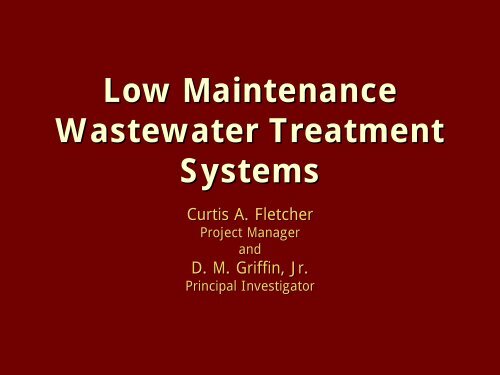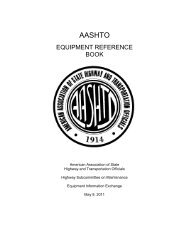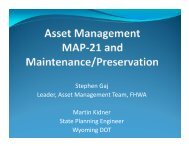Low Maintenance Wastewater Treatment using Rock Filter and ...
Low Maintenance Wastewater Treatment using Rock Filter and ...
Low Maintenance Wastewater Treatment using Rock Filter and ...
Create successful ePaper yourself
Turn your PDF publications into a flip-book with our unique Google optimized e-Paper software.
<strong>Low</strong> <strong>Maintenance</strong><br />
<strong>Wastewater</strong> <strong>Treatment</strong><br />
Systems<br />
Curtis A. Fletcher<br />
Project Manager<br />
<strong>and</strong><br />
D. M. Griffin, Jr.<br />
Principal Investigator
Topics to be Covered<br />
• Project History <strong>and</strong> Site Modifications<br />
• Results to Date<br />
• Ammonia Removal
View of Lake from Waste <strong>Treatment</strong> Plant
Boating for Pleasure
Fishing is popular both from the bank <strong>and</strong> from boats
Boating, Fishing <strong>and</strong><br />
Water Skiing are very Popular
Initial Flow Direction in each Cell<br />
Effluent Discharges to Lake
Current Flow
View of Waste <strong>Treatment</strong> Plant from Closest Picnic Pavilion (150 Feet)<br />
View of Lake in the Background
Inlet Manifold <strong>and</strong> Distribution Ports
“Highly” Technical Sampler
Adjustable Effluent Pipe
Cell 2 With Mature Plants<br />
(Lab Trailer in Background)
Cell 2 After Harvesting Plants
Plant Root Mass Wrapped Around Sample Port
Plant Root Mass & Sample Port
In-Place Skirpus Root System
Plant Root Mass (Sample Port Cap)
Cell 3 after Transferring <strong>Rock</strong> to Cell 4
Inmate Crew who Moved <strong>Rock</strong>
Cell 3 Partially Completed
Media Installation<br />
Inmates Lifting Synthetic Media Blocks
2’ x 2’ x 4’ blocks<br />
Synthetic Media<br />
(Kompakt Tubular Block Media)
Cell 3 Installation Complete<br />
Media Covered with L<strong>and</strong>scape Cloth
Cell 4 After Placing <strong>Rock</strong> From Cell 3<br />
(Note Sample/Observation Ports)
Cell 4 – <strong>Rock</strong> Media & Aeration Ports<br />
(3-5 Inch Diameter Granite Media)
Cell 4 Spray Aeration Port
Raw <strong>Wastewater</strong> Strength<br />
(Septic Tank Influent)<br />
1997-2004<br />
Mean/Median<br />
(mg/L)<br />
St<strong>and</strong>ard<br />
Deviation<br />
(mg/L)<br />
Number of<br />
Observations<br />
BOD 5<br />
563/491 349 156<br />
TSS 825/505 863 157<br />
TKN 119/116 40 133<br />
NH 3<br />
39/33 28 108<br />
NO 3<br />
2.8/1.1 3.7 129
Waste Strength at Splitter Box (Septic Tank Effluent)<br />
Mean/Median<br />
(mg/L)<br />
S.D.<br />
(mg/L)<br />
Number of<br />
Observations<br />
Loading<br />
Cell 3*<br />
(kg/ha*day<br />
)<br />
BOD 5<br />
177/177 55 116 85<br />
TSS 73/69 30 121 35<br />
TKN 105/103 31 92 50<br />
NH 3<br />
92/91 28 119 44<br />
NO 3<br />
1.88/0.45 2.7 128 0.9<br />
*Daily flow assumed to be long term average of 5200 gpd, loading value based on mean<br />
concentration
Effluent Cell 3<br />
Mean/Median<br />
(mg/L)<br />
S.D.<br />
(mg/L)<br />
Number of<br />
Observations<br />
BOD 5<br />
24.5/19.9 18.7 37<br />
TSS 10.8/7 9.7 37<br />
TKN 66/64 26 26<br />
NH 3<br />
37/36 26 35<br />
NO 3<br />
3.6/3.3 3.7 33
Waste Strength Effluent Cell 4<br />
Mean/Median<br />
(mg/L)<br />
S.D.<br />
(mg/L)<br />
Number of<br />
Observations<br />
BOD 5<br />
17.2/13.8 12.3 50<br />
TSS 6/5 4.8 40<br />
TKN 39.6/42.4 20.5 20<br />
NH 3<br />
17/13 16.4 22<br />
NO 3<br />
6.4/5.4 5.2 33
Temperature Variation at Splitter Box, Cells 3 & 4, Effluent<br />
GS2 May 28, 2006 9:00:54 AM<br />
25<br />
TEMP.SB<br />
Temp.cell.3<br />
temp.cell.4<br />
temp.cl.eff<br />
Temperature (C)<br />
20<br />
15<br />
10<br />
5<br />
12/1/2002 2/13/2003 4/28/2003 7/11/2003 9/23/2003 12/6/2003 2/18/2004 5/2/2004 7/15/2004 9/27/2004<br />
Figure 9 Temperature Variation Over Time
Total Suspended Solids in Cells 3 & 4 over Time<br />
TSS Concentrations Cells 3 <strong>and</strong> 4<br />
40<br />
TSS Concentration , mg/liter<br />
30<br />
20<br />
10<br />
cell 4<br />
cell 3<br />
0<br />
8/1/2002 2/17/2003 9/6/2003 3/25/2004 10/12/2004
Biological Oxygen Dem<strong>and</strong> (BOD) over Time<br />
4<br />
3<br />
2<br />
Pump Station<br />
Splitter Box<br />
Cell 1<br />
Cell 2<br />
10 3 2<br />
BOD, mg/liter<br />
6<br />
5<br />
4<br />
3<br />
2<br />
10 2<br />
6<br />
5<br />
4<br />
3<br />
2<br />
10 1<br />
6<br />
5<br />
4<br />
3<br />
curves are smoothing splines intended<br />
only to show trends in the data<br />
10 0<br />
8/13/1996 7/14/1997 6/14/1998 5/16/1999 4/15/2000 3/17/2001 2/15/2002 1/17/2003
Average Flow in Gallons Per Day over Time<br />
DAILY FLOW (GPM) AT GRAND PRAIRIE<br />
30<br />
GS2 Feb. 9, 2005 8:34:32 AM<br />
NET DAILY FLOW (GPM)<br />
20<br />
10<br />
LOESS REGRESSION FIT<br />
1 DEGREE<br />
0<br />
7/1/1997 5/17/1999 4/1/2001 2/15/2003 12/31/2004
Commercial Package Plant
Summary of Significant Operation Events<br />
• Hurricane Evacuation: This facility becomes a massive parking lot<br />
during hurricane evacuation, yet the waste treatment plant has not n<br />
been out of compliance because of the increased flow.<br />
• Storm Water Runoff: Flow rates increase to as much as 50 gallons<br />
per minute during thunder storms without ca<strong>using</strong> any treatment<br />
problems.<br />
• Local Events: Neither visits by groups of tour buses nor horse riding r<br />
events where the horse trailers have been washed out into the RV<br />
dump have caused any problems. BOD <strong>and</strong> TSS have increased, but<br />
not enough to cause any compliance or operation problems.<br />
• The water well washed out during one of the hurricanes <strong>and</strong> the<br />
increased flow was detected by the system flow measuring<br />
equipment. This could have caused serious damage if the increased<br />
flow with the associated increase in s<strong>and</strong> content in the flow stream<br />
had not been detected. The rest area could have been shut down<br />
for several weeks
Recommendations <strong>and</strong> Conclusions<br />
• Robust System: Successfully treats strong influent stream without<br />
serious problems.<br />
• Ease of Operation: Only exceeded the permit once in ten years<br />
because of a treatment plant problem; i.e., week of subfreezing<br />
temperatures. Effluent increased to 54 mg/L BOD while the permit<br />
limit is 45 mg/L. DOTD was not cited because the effluent average<br />
stayed well within the permit limits.<br />
• Continued Operation: Since research ended in 2004; the treatment<br />
system continues to meet the permit without a trained operator.<br />
Rest area attendants add chlorine tablets <strong>and</strong> call for assistance e if<br />
lift stations need maintenance.<br />
• Effluent has not been above 20 mg/L in BOD or TSS.<br />
• <strong>Rock</strong> <strong>and</strong> synthetic media filters have proven very successful in<br />
treating strong influent volumes of 10,000 gallons per cell (30’ x<br />
150’) ) with minimal maintenance.<br />
• This type of cell would be ideal for a pilot project since each cell is<br />
an independent system. Cells can be added to increase volume as<br />
desired. Individual cells can be shut down for maintenance <strong>and</strong><br />
inspection without affecting operations.<br />
• A pilot project could be built at very little cost since a plastic lining<br />
can be placed in a hole in the ground <strong>and</strong> then filled with selected<br />
media.
Son-in<br />
in-Law <strong>and</strong> Pepper after listening to Presentation








